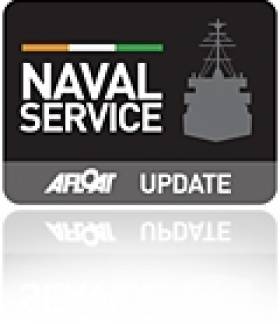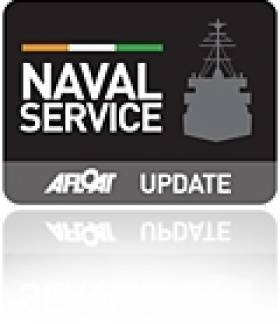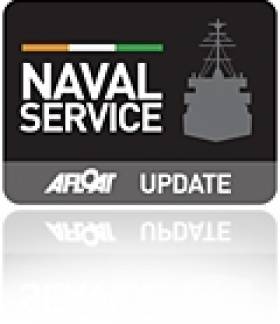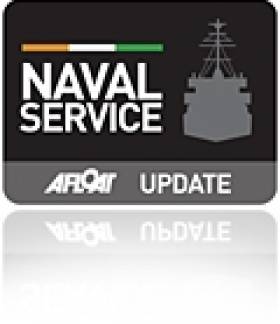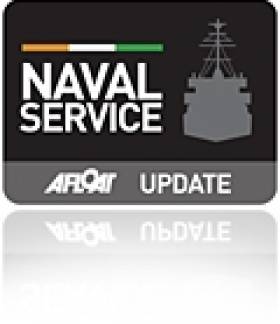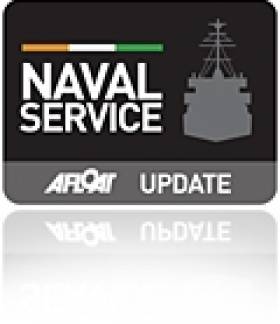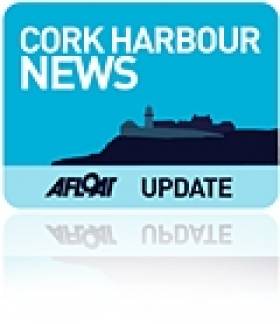Displaying items by tag: naval service
Government Ministers Meet Crew of L.É. Eithne in Malta
#EithneMalta - Minister for Defence, Simon Coveney, T.D. earlier today met Naval Service personnel crew of the L.É. Eithne (P31) in Valetta, Malta.
The flagship under the command of her captain, Commander Pearse O'Donnell and his crew are continuing to undertake a key role in assisting the Italian authorities with the migrant crisis in the Mediterranean.
The Minister is accompanied on his visit by Minister for Justice & Equality, Frances Fitzgerald, T.D. and Minister of State for Development, Trade Promotion and North-South Co-operation, Sean Sherlock, T.D.
Minister Coveney said" The recent rescue operations undertaken by the Irish Naval vessel and her crew to date have impacted significantly on the lives of so many people. Up to 30 June 2015, you have rescued 3,376 migrants in 22 rescue missions".
The Minister added "The work of our Naval Service in the Mediterranean is invaluable. The Naval Service will remain in the Mediterranean undertaking humanitarian search and rescue activity. L.É. Niamh (P52) will replace L.É. Eithne over the next week or so." The Minister went on to say "Ireland's focus will remain on continuing to assist the Italian authorities in the humanitarian search and rescue operation efforts to prevent further tragedy and loss of life at sea."
Minister Fitzgerald said "I am delighted to have the opportunity to pay tribute to the exemplary professionalism of the crew of the LÉ Eithne in humanitarian search and rescue. We are proud of them and the work they are doing under the Irish flag".
Minister Fitzgerald went on to say "Migration is one of the biggest challenges facing the EU and there are no easy answers. However Ireland is committed to doing its part in solidarity with our fellow Europeans in tackling that crisis. The deployment of LÉ Eithne shows the real difference that Ireland, as a comparatively small Member State, can make and we will continue to do what we can when we can as the situation evolves".
Minister of State Seán Sherlock added "the heroic work of our Defence Forces in this exercise has been humbling."
"The displacement caused by protracted conflict has had a devastating impact on the families who have had to flee their homes and communities. Many of these very vulnerable people have fled war and persecution to seek refuge here in Europe. Ireland is making a significant contribution to addressing the root causes of displacement in countries of origin, notably through our humanitarian and development assistance in the Horn of Africa and other regions of Africa and the humanitarian support which we provide in Syria and the region."
Minister Coveney concluded "on behalf of myself and the Irish Government, I would like to thank you all for your outstanding work in the Mediterranean to date. I wish you every success for the future and a safe return to your families."
Nomination for New Defence Forces Chief of Staff
#NewChiefOFstaff - Rear Admiral Mark Mellett DSM writes The Irish Times has been nominated by Minister for Defence Simon Coveney for the appointment by the President as chief of staff of the Defence Forces.
Rear Admiral Mellett was appointed to the position of deputy chief of staff of the Defence Forces in November 2013.
From Co Mayo, he joined the Naval Service in 1976. His first command was the LÉ Orla in 1992, followed by the LÉ Ciara in 1997 and the flagship LÉ Eithne in 2005 (see related report today).
He will succeed the current chief of staff Lt Gen Conor O'Boyle when he retires in September this year.
Mr Coveney congratulated Rear Admiral Mellet on his new appointment and said that he is looking forward to working with him in the future.
Cork Institute of Technology (CIT) President Dr Brendan Murphy said - "We are delighted with to hear of the appointment of Rear Admiral Mark Mellett as Chief of Staff of the Irish Defence Forces. CIT, since the foundation of the National Maritime College of Ireland ten years ago, has had a long and fruitful relationship with the Irish Naval Service and in particular with Rear Admiral Mellett is his role as Officer Commanding the Irish Naval Service. It has been a long and fruitful relationship particularly as Mark showed great strategic vision. He has been instrumental in the transformation of the Irish Naval Service to a knowledge based institution and the naval service now actively takes part in education and research, playing an important role in the economic development of the country as a whole. I, and CIT, wish him every success in his new role."
Conor Mowlds, Head of the National Marine College of Ireland said " I would like to echo Dr Murphy's words and to give my very best wishes Rear Admiral Mellett. His appointment will add strength to the voice of the growing Irish Maritime Community."
For further details of the career of the Rear Admiral, click here.
#EithneMedRescue – Naval Service 'flagship' LÉ Eithne (P31) successfully located and rescued 367 migrants on a wooden barge yesterday some 50kms north-west of Tripoli, the Libyan capital.
Almost the same number of migrants again on a barge were rescued earlier this month off the North African coast.
According to the Naval Service, conditions during this latest indicdent were choppy with the operation commencing at 7.25 am during a south easterly 1 metre high swell. All migrants were successfully taken on board by 10.09 am. On board the LÉ Eithne were 278 male, 80 female and 9 children where they received medical screening, food and water.
The LÉ Eithne next tasking will be under the direction of the Italian Maritime Rescue Co-Ordination Centre.
A month ago today LÉ Eithne departed Cork Harbour on the 16th of May to assist the Italian Authorities in the humanitarian search and rescue operations in the Mediterranean.
The role of the Irish Naval vessel will be to provide a search and rescue capability and to undertake humanitarian rescue operations at sea in the Mediterranean.
Assistance to persons in distress at sea will be provided in accordance with the applicable provisions of international conventions governing search and rescue situations.
The Naval Service vessel will be deployed in the Mediterranean for a period of up to six months over the summer period, subject to the operational demands and requirements arising in the theatre of operations.
#YeatsFinalJourney – Peter Murtagh of The Irish Times writes of a long forgotten record of the return to Ireland of the remains of WB Yeats.
The records emerged from the Military Archives and is available online to coincide with the 150th anniversary on Saturday of the poet's birth.
The body of the poet, who died in January 1939 and was buried at Roquebrune-Cap-Martin in south-eastern France, was brought by sea from Nice to Galway in September 1948 for reinterring in Drumcliffe Churchyard in Co Sligo. It was transported by the LE Macha, the first overseas deployment of a ship of the Naval Service.
The operation was overseen by the then minister for external affairs, Sean McBride, son of Maud Gonne-McBride, the subject of unrequited, but poetically inspiring, amour from the poet.
The rediscovered record of the repatriation includes just over 30 minutes of film - silent, grainy and mostly black and white footage of the Macha's mission; more than 80 black and white photographs; the ship's log; and five informal letters to the first head of the Naval Service, Captain HJ Jerome, from an officer on board the Macha, Commander Thomas McKenna, who in due course succeeded Capt Jerome to lead the service.
To this has been added a recording of the only surviving member of the crew, former Petty Officer Patrick Campbell, who is now aged 90 but has a clear recollection of the mission.
"When we docked in Nice there was great excitement because it was the first Irish ship [there flying the] tricolour. We did get a good reception," Mr Campbell told a researcher at the Archive after his daughter, Antonette, contacted the Defence Forces earlier this year saying her father had a story to tell.
For much more, The Irish Times reports here.
400 More Med Migrants Plucked by Irish Navy
#EithneMedRescue - LÉ Eithne (P31) the Navy Service flagship writes the Independent.ie, has rescued more than 500 men, women children and infants desperately attempting to cross the Mediterranean this weekend.
Yesterday morning the ship rescued 310 migrants from a barge floating in the Mediterranean 40km north of Libya.
Then at 5pm the LÉ Eithne located and rescued migrants on two inflatable craft -this time with 89 persons on board - some 75 kilometres north of Libya. Conditions at the time were good and the operation took two hours.
There are now 399 rescuees on board the Irish ship who owe their lives to the skilled Irish naval services. They number 280 men, 78 women and 41 children in total and will be transferred to other vessels to bring them safely to shore.
On Friday, the LÉ Eithne rescued another 113 migrants adrift on a rubber inflatable dinghy north of Tripoli. They were all given food and water once they were safely on board and then transported to shore.
The LÉ Eithne has now saved more than 1,000 people since it left Cork three weeks ago on May 16 (as previously reported on Afloat.ie)- sailing to assist the Italian authorities in the ongoing search- and-rescue mission in the southern Mediterranean waters.
For more on the story click here.
#SixServiceFleet - The deployment of LÉ Eithne (P31) on a humanitarian mission to the Med, the fate of 'Aoife' and delays of newbuild OPV James Joyce, sees the Naval Service fleet reduced to 6 patrol vessels operating within Irish waters, writes Jehan Ashmore.
In recent years the Naval Service had a 8-strong fleet with the inclusion of LÉ Emer (P21) and sister LÉ Aoife (P22), however the former Offshore Patrol Vessel was sold overseas to Nigerian interests in 2013. This year the 'Emer' was transferred to the west African state's navy.
The 'flagship' LÉ Eithne commissioned as a Helicopter Patrol Vessel (HPV) made a transit of the Strait of Gibraltar this Tuesday heading for an Italian base port, yet the issue surrounding the decommissioned Aoife remains unresolved. This followed an Irish Government proposal to 'donate' the OPV to Malta but rebuffed by certain quarters of the island state's military as to her unsuitability in migrant SAR duties.
Afloat.ie has asked the Department of Defence for an update which responded with the same reply as previously reported (see report Aoife's almost full-circle role) in that the 'Department are in discussions with the Maltese authorities in relation to the modalities to be agreed in relation to the transfer of ownership of the decommissioned LÉ Aoife'.
As for the second newbuild Offshore Patrol Vessel (OPV) 90 class, James Joyce, she remains at the Babcock Marine & Technology Shipyard, Appledore in north Devon. As previously reported a month ago the newbuild had 'technical' issues following her first sea-trials that took place in March off Lundy Island in the Bristol Channel.
The Department however added that further trials of the James Joyce have since taken place.
It was also then reported last month that the €54m James Joyce would make her delivery voyage within weeks followed by a commissioning ceremony due this month. Whenever this ceremony takes place James Joyce will officially be designated with the ship's name prefix L.É. that means Long Éireannach or Irish Ship.
Currently the fleet that is in Irish waters comprises of a pair of 'Peacock' class coastal patrol vessels (CPV), three OPV's in the form of the sole remaining 'Emer' (modified Deirdre class) and a pair of 'Roisin' class OPV80s. The final unit is made of one Large Patrol Vessel (LPV) that been an enhanced version of the 'Roisin' class in the form of the 'Beckett' OPV90 class.
The Naval Service fleet of 7-strong patrol vessels are listed below.
HPV L.É. Eithne (P31) flagship (currently on overseas deployment)
CPV L.É. Orla (P41)
CPV L.É. Ciara (P42)
OPV L.É. Aisling (P23)
OPV L.É. Roisin (P51)
OPV L.É. Niamh (P52)
LPV L.É. Beckett (P61)
Each vessel is equipped with state of the art machinery, weapons, communication's and navigation systems.
In addition the Naval Service have on contract with Babcock Marine for a third and final sister of James Joyce which is due for delivery in 2016.
#EithneEntersMed - Naval Service flagship LÉ Eithne (P31) this evening entered the Strait of Gibraltar on her way to assist in the Mediterranean's migrant crisis, writes Jehan Ashmore.
The deployment of the 1,800 tonnes HPV is to enable in the search and rescue (SAR) of refugee migrants from mostly small craft that face the danger of sinking and loss of life.
She had departed her Naval Base homeport of Haulbowline, Cork Harbour on Saturday. Since her departure three days ago at the naval base is where Minister of Defence Simon Coveney was joined by An Taoiseach Enda Kenny T.D. to meet the crew of 70 in total. Two crew members are from the Army Medical Corps to assist refugees in an ever worsening migrant crisis.
The Cork built flagship dating from 1984 was commissioned originally as a Helicpoter Patrol Vessel (HPV) hence the extensive aft-deck space and adjoining hanger which will be used by boarding migrants.
It is also understood that the three RIBs will provide rapid reaction launch missions to assist in SAR operations. The need for such RIB craft will step up efforts as the growing numbers of refugees flee north Africa having fled war-torn regions of the Middle East and swathes of northern Africa.
The RIBS will be launched to aid sinking craft laden with refugees. Many of these unseaworthy craft used by people-traffickers are then abandoned except for the 'human-cargo' left to drift.
LÉ Eithne is expected to reach Italy this weekend (if not before) and to where the countries authorities will preside in the overall running of humanitarian operations.
This is the first time that an Irish Naval Service vessel has been involved in a humanitarian role overseas.
The base port to where LÉ Eithne is assigned has not been disclosed by the Department of Defence for operational security reasons. It is reported that the deployment duration in the Mediterranean is for two months and then the 80m flagship will be relieved by another Irish patrol vessel.
#EithneMedCrisis – It has been confirmed LÉ Eithne (P31) is to depart Cork Harbour this morning on a humanitarian mission to the Mediterranean as previously reported on Afloat.ie following discussions held between Irish and Italian authorities, writes Jehan Ashmore.
The deployment of the 1,800 tonnes 'flagship' is for a period of six months by the Minister of Defence Simon Coveney T.D. was recently given approval by Government. Joining the Minister this morning in the Naval Base Haulbowline, Cork Harbour was An Taoiseach Enda Kenny T.D. who met the crew before the HPV vessel departs for the Mediterranean.
At the ceremony, the Minister stated that "The humanitarian crisis in the Mediterranean is of great concern to Ireland. The quick response by the Irish Government in deciding to despatch a Naval Vessel highlights our commitment to assist with efforts to prevent further tragedy and loss of life at sea."
The Minister further stated that "The despatch of an Irish naval vessel represents a tangible and valuable Irish national contribution to assisting the Italian authorities in the humanitarian search and rescue operation."
A crew of 68 personnel from the Permanent Defence Force and 2 medical staff from the Army Medical Corps will assist Italian authorities in the carrying out of humanitarian search and rescue of refugees subject to the operational demands and requirements.
It is understood this is the first time in almost 60 years that an Naval Service vessel is to be deployed for humanitarian purposes.
The Minister concluded by saying "I wish to commend the Defence Forces on their efficient operational and logistical planning for this deployment. I want to wish each and every crew member of L.É. Eithne, under the command of Commander Pearse O'Donnell, a safe and successful mission. You will be in our thoughts throughout the duration of your tour of duty."
The 31 year-old L.E.Eithne was launched in 1984 as a Helicopter Patrol Vessel (HPV) which used to carry a 'Dauphin' helicopter on the extensive aft- deck. Next to the aft-deck is an adjoining hanger which will further assist in her new role in the rescue of refugees.
Note to the left of the twin funnels (abreast) with the hanger area below is a RIB and associated derrick (click photo from previous report) which was not part of the original ship when completed by Verolme Cork Dockyard. It is understood this RIB that rests on a cradle structure brings to three RIB craft onboard.
As the numbers of fleeing migrant refugees rises from war-torn regions in the Middle East and throughout northern swathes of the African continent, the EU has stepped up its efforts to assist authorities.
Among the nations already involved are the UK which has its 'flagship' HMS Bulwark carrying out rescue of refuges using the amphibious vessels fleet of landing craft.
Government to Deploy L.É. Eithne to Assist in Humanitarian Crisis in the Mediterranean
#EithneMedCrisis - Minister for Defence, Simon Conveney, T.D. has been given approval by the Government today (12 May) for the deployment of a Naval Service vessel to undertake humanitarian search and rescue missions as previously reported on Afloat.ie in the Mediterrranean.
The last Irish built naval service vessel L.E.Éithne (P31) dating from 1984 whose career was also previously reported will have a crew of around 65 personnel of the Permanent Defence Force are to undertake the task. The decision is subject to finalisation of appropriate arrangements with the Italian authorities.
Following the Government Decision the Minister commented "subject to finalisation of arrangements with the Italian authorities, the L.É. Eithne will be despatched to the Mediterranean without any delay. Operational and logistics planning for the deployment have been completed and the 80m vessel which has a range of 7,000nm at 15 knots is ready to deployed. The humanitarian crisis in the Mediterranean is of great concern to Ireland and to our EU partners. I am anxious that we commence search and rescue activities in the Mediterranean as soon as it is feasible to do so".
The Minister went on to say that "discussions are at an advanced stage with the Italian authorities on arrangements covering a number of issues relating to the deployment of the Vessel. I expect that the Ship should depart the Naval Base in Haulbowline on Saturday, subject to confirmation of the proposed arrangements by the relevant Italian authorities".
Ireland will deploy L.É. Eithne to the Mediterranean for a period of up to six months over the summer period, subject to the operational demands and requirements arising in the theatre of operations, to assist the Italian authorities in the humanitarian search and rescue operations.
The Minister highlighted the Government's commitment to continuing Ireland's strong tradition of peacekeeping and stated that "the proposed deployment of an Irish Naval Service vessel to the Mediterranean will bring the number of Defence Forces personnel deployed overseas to approximately 500 Irish personnel."
#CorkHarbour - Marine Minister Simon Coveney last Friday (1 May) officially re-opened the newly remediated Haulbowline Island Bridges at Cork Harbour.
The bridges have undergone extensive repairs and upgrades as part of the early preparatory phase of the Haulbowline Island Remediation Project.
This long-delayed project is set to transform the former Ispat/Irish Steel site on the island into a major public amenity area.
When completed, it will also provide a potential future development location for the Naval Service, which is headquartered on the island.
It is not yet known, however, whether future plans for the island will also include an 'Ocean Racing Yacht Hub' within the Naval Service base.
Reopening of the bridges, which represents the sole land-based road access point to the island, allows for the core remediation of the island's East Tip and the former factory site to proceed later in 2015 – a year after the EPA granted the necessary waste licence.
"The completion of this significant piece of infrastructural work, apart from being a major engineering achievement in its own right, paves the way for the long awaited core remediation work to proceed," said Minister Coveney.
"Once completed this project will usher in an entirely new phase of this island’s long and distinguished history and represents tangible evidence of the Government’s commitment to Cork Harbour and to the wider marine sector."
The minister commented Cork County Council, consultants RPS Consulting Engineers and contractors LM Keating Ltd for carrying out the work within a relatively tight timeframe and within budget.
He also paid tribute to the Naval Service for facilitating the refurbishment and for ensuring that its day-to-day work was not impacted throughout the busy construction phase.
The upgrade was financed as part of a €40 million package signed off in October 2011 to clean up the toxic waste site at the former steelworks. Full details of the planned work are available at www.corkcoco.ie.




























